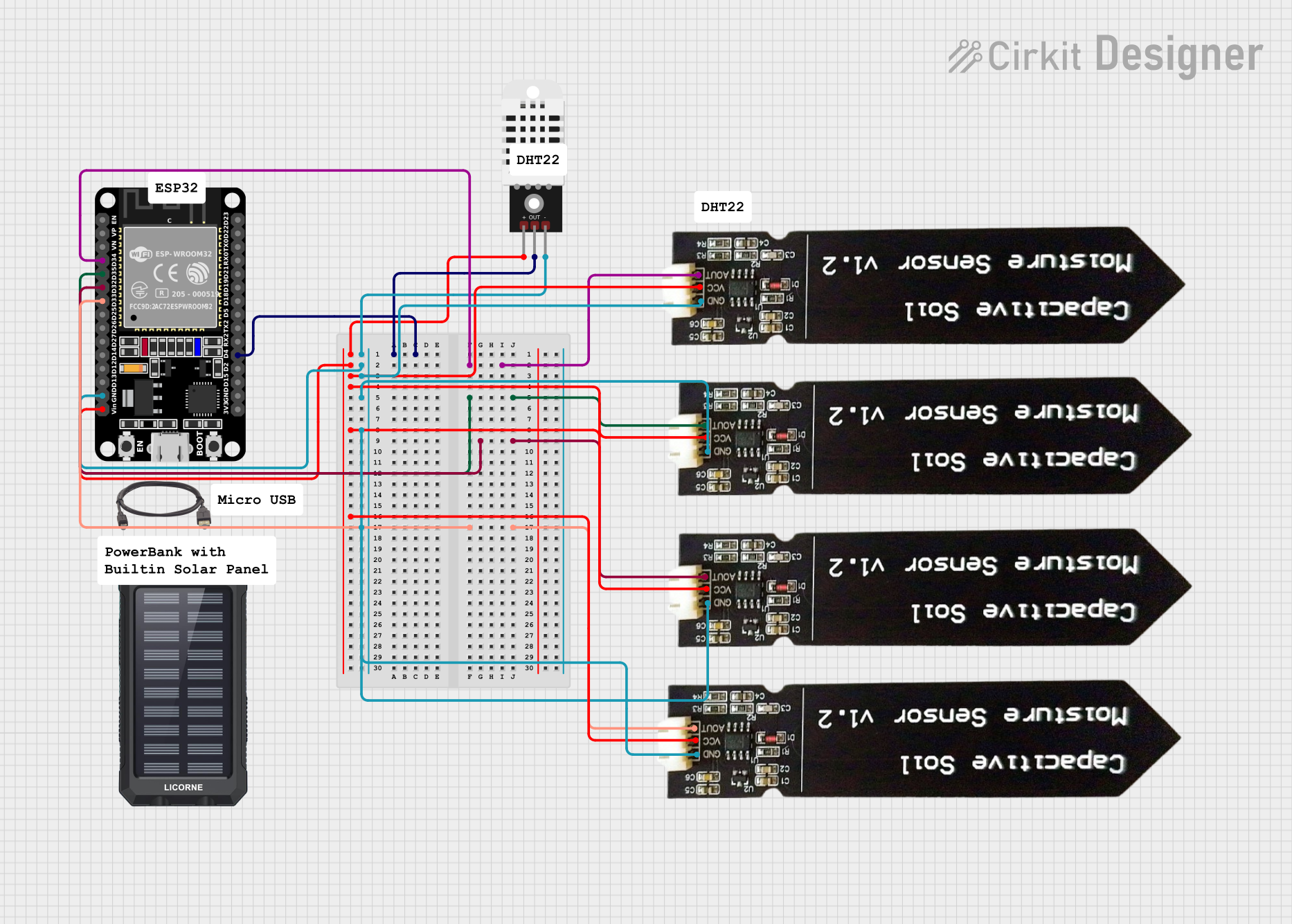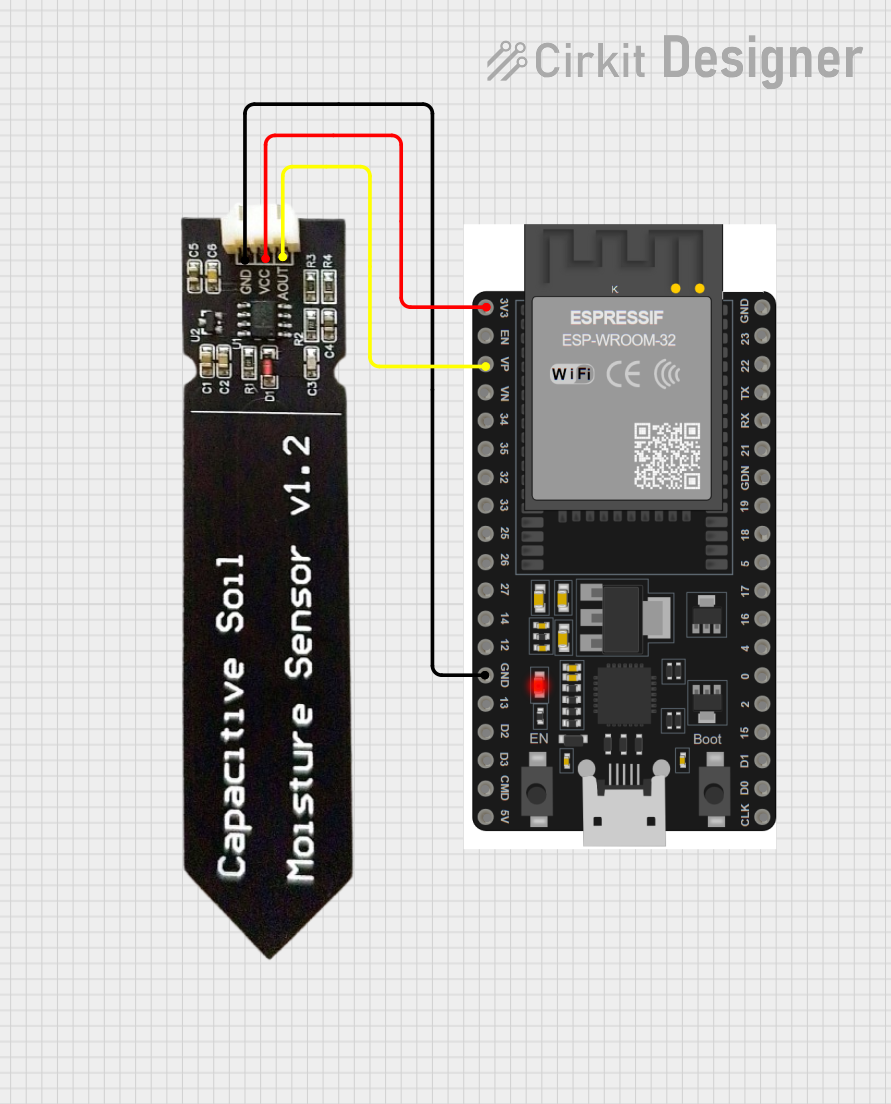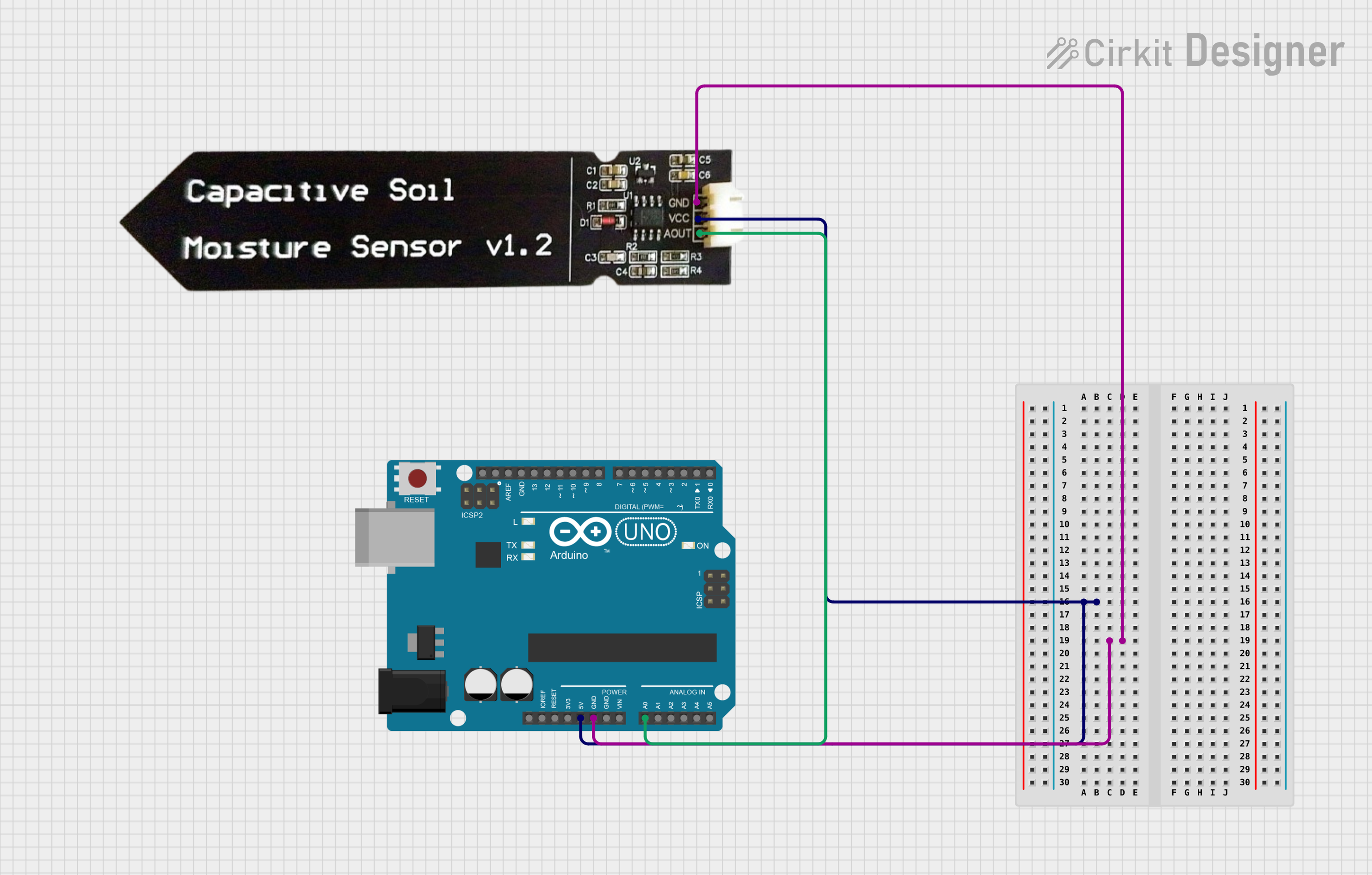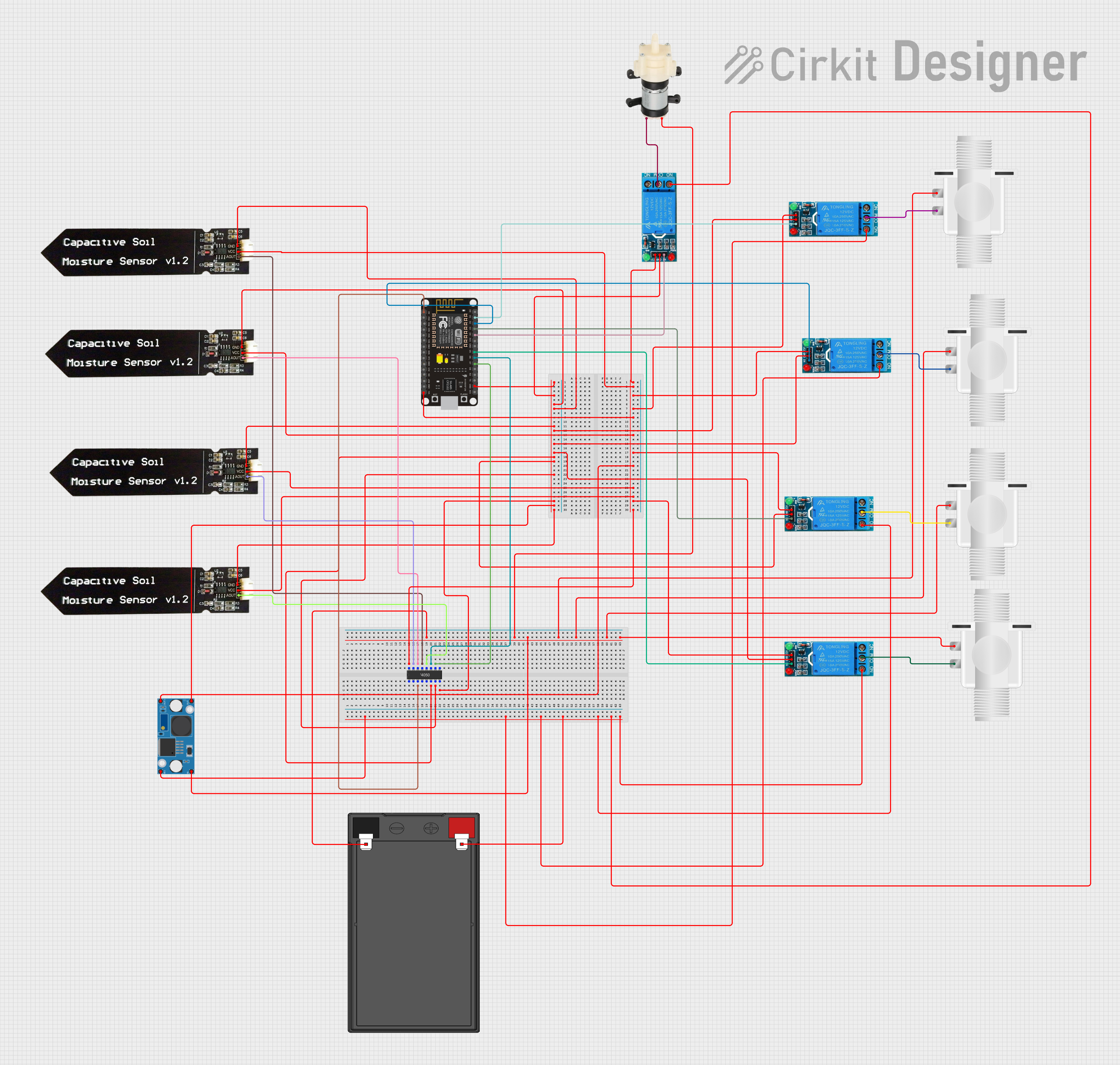
How to Use Capacitive Soil Moisture Sensor v1.2: Examples, Pinouts, and Specs

 Design with Capacitive Soil Moisture Sensor v1.2 in Cirkit Designer
Design with Capacitive Soil Moisture Sensor v1.2 in Cirkit DesignerIntroduction
The Capacitive Soil Moisture Sensor v1.2 is a reliable and efficient tool for measuring the volumetric water content in soil. Unlike resistive soil moisture sensors, this capacitive sensor detects changes in soil capacitance, which varies with moisture levels. This design minimizes corrosion and ensures a longer lifespan, making it ideal for long-term use in agricultural, gardening, and environmental monitoring applications.
Explore Projects Built with Capacitive Soil Moisture Sensor v1.2

 Open Project in Cirkit Designer
Open Project in Cirkit Designer
 Open Project in Cirkit Designer
Open Project in Cirkit Designer
 Open Project in Cirkit Designer
Open Project in Cirkit Designer
 Open Project in Cirkit Designer
Open Project in Cirkit DesignerExplore Projects Built with Capacitive Soil Moisture Sensor v1.2

 Open Project in Cirkit Designer
Open Project in Cirkit Designer
 Open Project in Cirkit Designer
Open Project in Cirkit Designer
 Open Project in Cirkit Designer
Open Project in Cirkit Designer
 Open Project in Cirkit Designer
Open Project in Cirkit DesignerCommon Applications
- Automated irrigation systems
- Smart gardening projects
- Agricultural soil monitoring
- Environmental research and data logging
- DIY electronics and IoT projects
Technical Specifications
The Capacitive Soil Moisture Sensor v1.2 is designed for ease of use and compatibility with microcontrollers like Arduino and Raspberry Pi. Below are its key technical details:
| Parameter | Specification |
|---|---|
| Operating Voltage | 3.3V - 5.5V |
| Output Signal | Analog voltage (0-3.0V typical) |
| Current Consumption | < 20mA |
| Measurement Range | 0% - 100% soil moisture |
| Interface Type | Analog |
| Dimensions | 98mm x 23mm x 3mm |
| Weight | ~15g |
Pin Configuration and Descriptions
The sensor has a simple 3-pin interface for easy integration into circuits:
| Pin | Name | Description |
|---|---|---|
| 1 | VCC | Power supply pin. Connect to 3.3V or 5V from the microcontroller or power source. |
| 2 | AOUT | Analog output pin. Provides a voltage proportional to soil moisture levels. |
| 3 | GND | Ground pin. Connect to the ground of the power supply or microcontroller. |
Usage Instructions
How to Use the Sensor in a Circuit
Wiring the Sensor:
- Connect the VCC pin to the 3.3V or 5V power supply of your microcontroller.
- Connect the GND pin to the ground of your microcontroller.
- Connect the AOUT pin to an analog input pin on your microcontroller (e.g., A0 on an Arduino UNO).
Placement:
- Insert the sensor into the soil at the desired depth. Ensure the sensor is fully in contact with the soil for accurate readings.
- Avoid placing the sensor in waterlogged soil for extended periods, as this may affect its performance.
Reading the Output:
- The sensor outputs an analog voltage that corresponds to the soil moisture level. A higher voltage indicates drier soil, while a lower voltage indicates wetter soil.
Important Considerations and Best Practices
- Calibration: The sensor's output may vary depending on soil type. Perform a calibration by measuring the output voltage in dry and saturated soil to determine the range for your specific application.
- Power Supply: Use a stable power source to ensure consistent readings.
- Environmental Protection: While the sensor is designed to resist corrosion, avoid prolonged exposure to water or extreme environmental conditions to extend its lifespan.
- Signal Noise: Use a capacitor (e.g., 0.1µF) between the AOUT and GND pins to reduce noise in the analog signal.
Example Code for Arduino UNO
Below is an example of how to use the Capacitive Soil Moisture Sensor v1.2 with an Arduino UNO:
// Capacitive Soil Moisture Sensor v1.2 Example Code
// This code reads the analog output of the sensor and prints the soil moisture
// level to the Serial Monitor.
const int sensorPin = A0; // Analog pin connected to the sensor's AOUT pin
int sensorValue = 0; // Variable to store the sensor reading
void setup() {
Serial.begin(9600); // Initialize serial communication at 9600 baud
pinMode(sensorPin, INPUT); // Set the sensor pin as an input
}
void loop() {
// Read the analog value from the sensor
sensorValue = analogRead(sensorPin);
// Map the sensor value to a percentage (0% to 100%)
int moisturePercent = map(sensorValue, 1023, 0, 0, 100);
// Print the moisture percentage to the Serial Monitor
Serial.print("Soil Moisture: ");
Serial.print(moisturePercent);
Serial.println("%");
delay(1000); // Wait for 1 second before taking the next reading
}
Troubleshooting and FAQs
Common Issues and Solutions
No Output or Incorrect Readings:
- Cause: Loose or incorrect wiring.
- Solution: Double-check all connections, ensuring the VCC, GND, and AOUT pins are properly connected.
Fluctuating or Noisy Readings:
- Cause: Electrical noise or unstable power supply.
- Solution: Add a decoupling capacitor (e.g., 0.1µF) between the AOUT and GND pins to stabilize the signal.
Sensor Not Responding:
- Cause: Damaged sensor or incorrect voltage supply.
- Solution: Verify the power supply voltage is within the specified range (3.3V - 5.5V). Replace the sensor if it is damaged.
Inconsistent Readings in Different Soils:
- Cause: Soil type affects capacitance.
- Solution: Calibrate the sensor for the specific soil type by measuring the output in dry and saturated conditions.
FAQs
Q1: Can this sensor be used in hydroponics?
A1: Yes, but ensure the sensor is not submerged in water for extended periods, as it is designed for soil use.
Q2: How do I interpret the analog output voltage?
A2: The output voltage decreases as soil moisture increases. Calibrate the sensor to map the voltage range to moisture percentages.
Q3: Is the sensor waterproof?
A3: The sensor is water-resistant but not fully waterproof. Avoid submerging it in water.
Q4: Can I use this sensor with a Raspberry Pi?
A4: Yes, but since the Raspberry Pi lacks analog input pins, you will need an ADC (Analog-to-Digital Converter) module to read the sensor's output.
By following this documentation, you can effectively integrate the Capacitive Soil Moisture Sensor v1.2 into your projects and ensure accurate soil moisture monitoring.